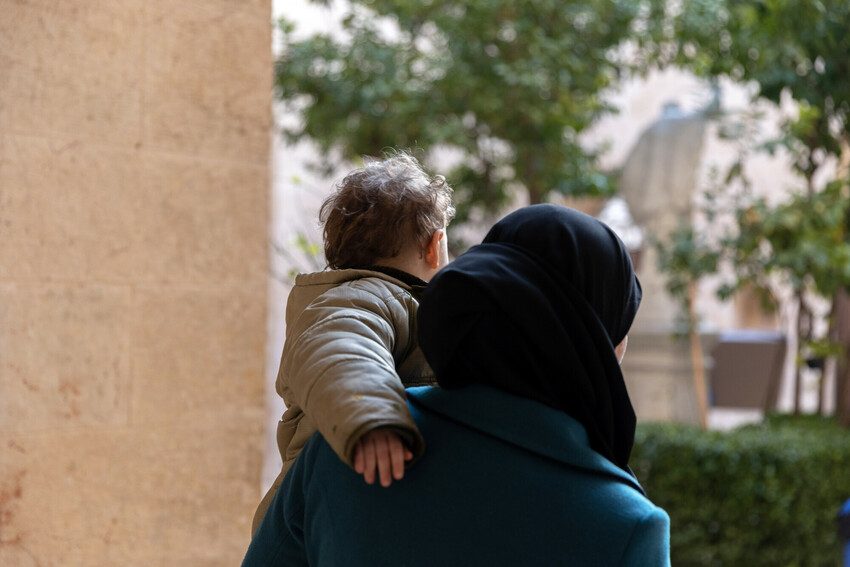Supporting the future of Syria and the region
Plan International on the Brussels VIII Conference 2024
30 April 2024On the occasion of the Brussels VIII Conference 2024 on the future of Syria and the region, Plan International shares 6 recommendations on how to best support people affected by the crisis.

Mother and baby sheltering in church in Aleppo, Syria, following the 2023 earthquake. Credit: Plan International.
It has been 13 years since the crisis in Syria began, yet amidst a world preoccupied with emerging challenges, the Syrian conflict finds itself increasingly marginalised. By 2024, 16.7 million people out of a total population of 23.46 million require humanitarian assistance, with children constituting 45% of those in need. This represents a significant increase from the 15.6 million reported in 2023. After more than a decade of conflict, Syrians face heightened risks of malnutrition, health issues, lack of education, and protection concerns, compounded by inadequate access to water, sanitation, and hygiene services.
Approximately 7.2 million Syrians remain displaced, and over 2.5 million Syrian children are deprived of access to education. The humanitarian situation has worsened following the 2023 earthquake, one of the most severe natural disasters in the region this century, resulting in widespread displacement and exacerbating vulnerabilities, particularly among women and children.
Despite the ongoing humanitarian crisis and its enduring impacts—ranging from conflict and displacement to social tensions, natural disasters, economic decline, and limited livelihood opportunities—the attention on the Syria crisis is waning.
Amid a landscape marked by a proliferation of conflicts, crises, and disasters, alongside the looming spectre of climate change and their root causes on a global scale, attention spans have increasingly shortened, resulting in neglected crises as newer ones emerge. The Gaza crisis serves as a poignant example of how the Syria crisis has been pushed down the list of priorities, despite its spill over effects on multiple countries, including Syria, Lebanon, Jordan, and Egypt.
Consequently, efforts to address these interconnected needs and crises have become increasingly fragmented. This poses a visible challenge to addressing the Syrian crisis, which is at risk of becoming a “forgotten crisis”. Despite this label, the crisis’s persisting impacts continue to profoundly affect vulnerable populations and communities, emphasising the critical importance of strengthening resilience in Syria and neighbouring countries to address escalating humanitarian needs.
Neglecting the crisis in Syria poses a significant risk of destabilising the entire region. Failure by global agendas to prioritise the Syrian crisis amidst competing priorities will further contribute to a landscape of regional instability.
Syria currently represents the world’s largest refugee crisis in 2024, accounting for nearly 25% of the global refugee population. Since the crisis began, over 14 million Syrians have been displaced from their homes in search of safety. More than 6.8 million have been internally displaced within Syria, while millions more have embarked on perilous journeys to seek refuge in neighbouring countries such as Lebanon, Jordan, and Turkey.
Plan International recommendations
Amidst numerous crises competing for attention and resources, including spillover effects and interconnected crises within the region, diminishing funding for the Syria crisis poses a dangerous and destabilising impact on the region and beyond. This situation risks fostering the resurgence of terrorism, increasing hostility towards refugees, heightening conflicts, boosting displacement flows, renewing refugee movements within the region, and exacerbating migration abroad.
- Demand a focused commitment from the global community at this critical juncture to prevent the Syria crisis from being forgotten and ensure adequate funding levels to effectively address humanitarian response plans and meet the escalating humanitarian needs in the region.
- Funding should recognise the need to support social cohesion programming, effectively demonstrating the mutual benefits for both communities, as a means to promote and better facilitate inclusion and integration. This support should include capacity-sharing, human resources, and risk management for locally led organisations and provide for these organisations to design activities with long-term objectives. Successful examples of activities that have benefited both communities in Lebanon include rehabilitating wells and pumping stations to provide water to all, other sectors that have witnessed some success include energy, health, and nutrition.
- Prioritise long-term economic support to host countries as part of a comprehensive response to the Syrian refugee crisis. By investing in infrastructure, job creation, education, and economic integration, host countries can harness the potential of refugees as contributors to economic growth and stability.
- Humanitarian response in Lebanon should not just focus on refugees, but on vulnerable persons in Lebanon, whether they be citizens or refugees. Focusing on vulnerabilities, rather than status, with a particular focus on children.
- Donors and international actors must advocate for the recognition of the needs of Syrian refugees within host countries, their integrated access to education, livelihood opportunities, among other services either within the international refugee law framework, or the human rights framework as applicable.
- Reforming the coordination mechanism to engage all levels of government, stakeholders, and humanitarian actors and explore opportunities to leverage development programming, adopting regional approaches, could add significant benefit to humanitarian and development efforts.


